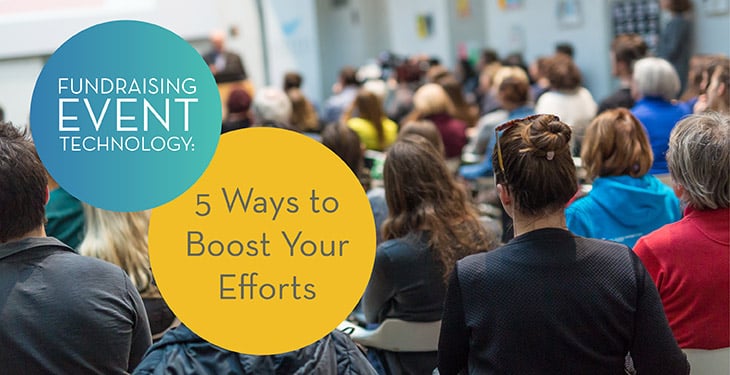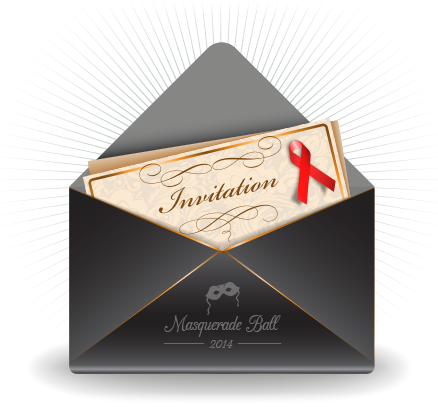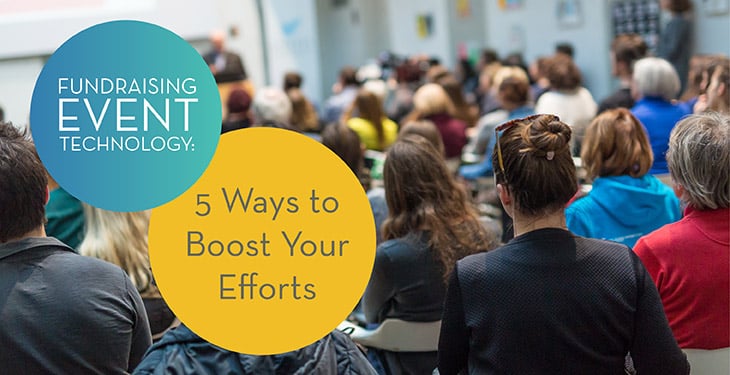 Fundraising events are an important part of your nonprofit’s annual calendar. They’re wonderful occasions to celebrate your community and supporters while raising money for your cause.
Fundraising events are an important part of your nonprofit’s annual calendar. They’re wonderful occasions to celebrate your community and supporters while raising money for your cause.
How can you take fundraising events to the next level? By using technology to improve upon existing strategies! Take a load of stress off your shoulders by leveraging new innovations to make your events run more smoothly than ever.
Today we’ll look at the following strategies to incorporate technology into fundraising events:
- Send out invites and track RSVPs electronically.
- Make use of prospect and donor research resources.
- Invest in event planning and guest management software.
- Incorporate online giving into your event.
- Use technology to automate your follow-up process.
Every event is unique, but you can streamline event planning and preparation by implementing some of these new technologies.
If you’re ready to learn more about incorporating technology into charity events, let’s dive in!

1. Send out invites and track RSVPs electronically.
 Whether you’re planning a silent auction, gala or fun run, your event needs the attendance of your supporters to succeed!
Whether you’re planning a silent auction, gala or fun run, your event needs the attendance of your supporters to succeed!
There are many ways to invite people to your events: direct mail, email, social media outreach, phone calls, and more. But with the help of some smart software, your invitation strategy can be more effective than ever.
First, make use of all the data your CRM stores about your supporters. Some data points to keep in mind (and in your CRM!) when sending out invitations:
- Preferred method of communication.
- Familial connections with other donors.
- Updated contact information.
- Previous event attendance record.
With this information, you can personalize your invitation strategy to each supporter to make your invitation as effective as possible.
If you’re inviting donors via an email campaign, consider segmenting your supporter list into smaller lists and sending more personalized email invitations.
By tracking your conversion rate or click-through rate, you can learn which communication strategies are most effective. Try experimenting with different images, email lengths, RSVP button placements, and more.
{{cta(‘661274c0-1d2e-4806-a547-596f67dbe59d’,’justifycenter’)}}
Once the RSVPs start rolling in, use your CRM to keep track of who has said yes, no, and maybe. Follow up with the maybes with more information, and the nos with information on how else to get involved or donate!
Using technology to stay on top of your event promotion, invitations, and responses is a quick and easy way to make sure that no one slips through the cracks, and that you can use your time following up most efficiently.
2. Make use of prospect and donor research resources.
Chances are that your nonprofit already conducts prospect research when running major fundraising campaigns. Have you considered using this strategy to optimize your fundraising event success?
Prospect research, or donor research, involves using publicly available information to gauge a prospect’s capacity or affinity for giving.
Capacity for giving is determined by:
- Real estate ownership.
- Boat or vehicle ownership.
- SEC holdings.
- Business affiliations.
These are all traditional wealth markers, or indicators of how much income a person might have. The higher the indicated income, the higher the capacity for giving. However, as you know, simply having the capacity doesn’t mean that someone will feel moved to donate.
That’s why prospect research also focuses on affinity for giving, which is measured through:
- Previous interactions with your nonprofit.
- Previous donations or other engagements with other nonprofits.
- History of political giving.
The best indication of future giving is past giving, so learning about a person’s philanthropic habits can be very helpful for planning your solicitations.
A prospect’s philanthropic behaviors can also be useful for determining what drives them to give. If they have a history of donating to nonprofits with missions like yours, you know that you should emphasize the similar aspects of your mission while talking to them.
Before your event occurs, conduct prospect or donor research on your invite list. If you find people with potential to be a major donor, prioritize following up with them and getting to know them at the event.
You might also find all different ranges of givers in attendance as friends of your current donors. Doing research on attendees beforehand will give you a hand in making them feel welcome and wanted at your event.

3. Invest in event planning and guest management software.
Planning a successful fundraising event can be a hassle. There are so many moving parts to every event, and it can be hard to keep track of everything!
That’s why we suggest investing in event planning or guest management software. By using a trustworthy and easy-to-implement platform for event planning, you can remove the possibility of human error and keep everyone on the same page.
To help you get started on deciding which event planning software to invest in, check out this guide to nonprofit fundraising event software from Double the Donation. With so many options, you’ll be sure to find the right one for your organization.
But what should you be looking for in your new software?
- A personalized registration program. Attendees should be able to purchase tickets or register online, through desktop or mobile. Your team should be able to edit this registration page to include fields for all necessary information, like food allergies or preferences.
- A user-friendly check-in system. Your event will run much more smoothly if your volunteers or staff can check in attendees upon arrival without worrying about complicated spreadsheets or splitting up attendees by last name. All team members should have access to all attendee information required for checking in.
- An option for tiers of attendees. If your event has different prices for different types of registrations (think basic packages versus VIP packages, with different perks and prices), your attendees should be able to indicate which they want in their registration.
Your organization might have different needs, based on what types of events you host, but functionality and ease of use are important for everyone.
For a dinner party or charity auction, you might prioritize buying an event planning software that allows you to plan out strategic seating charts ahead of time. If you tend to host conferences or concerts, you’ll want a software with a more intensive scheduling tool.
No matter what events your organization hosts, there’s a software out there that can make it easier.
4. Incorporate online giving into your event.
The point of your event is to raise funds for your organization, so let technology and mobile fundraising make it as easy as possible for your attendees to give.
There are many different ways to donate that your nonprofit needs to be prepared for, so make sure you give your attendees options! Some may prefer cash and check, some credit cards, and some through their phones.
Consider these popular options when planning your next fundraising event.

Text-to-give services.
Nearly everyone has smartphones these days, and most people don’t go anywhere without them! Let this ubiquitous technology work for your nonprofit by turning it into a vehicle for easy mobile fundraising.
Text-to-give services use a phone’s native texting app and web browser to support a fundraising endeavor. Donors text a keyword to the number provided by your text-to-give vendor, and then the vendor automatically sends back a link to a mobile donation page.
The whole process takes only minutes and relies on things that your donor is already comfortable doing!
For more information on using text-to-give during your next event, check out the ultimate text-to-give guide from OneCause.
Giving kiosks.
Giving kiosks are a quick and easy way to let donors make donations via their credit cards, without having to type their card information into a form.
Set up your kiosk in a central and visible location at your event, and draw attention to it with signs and periodic announcements.
Make your kiosk easy to use by minimizing the necessary steps and offering suggested gift amounts.
Peer-to-peer fundraising.
Incorporating peer-to-peer fundraising into your events is a great idea because it helps build anticipation for your events, by getting your supporters actively involved in the success of your fundraiser.
It also expands the list of potential invitees from just the community around your nonprofit to the social networks of your communities!
Peer-to-peer fundraising, or social fundraising, calls on supporters of your nonprofit to market a donation page to their friends and family on social media in order to raise money for your cause.
With the advent of social media sharing, peer-to-peer fundraising is a great way to transcend time zones and geographic boundaries to reach people all over the world.
You never know where your supporters have friends and family! Use peer-to-peer fundraising as a fun online giving tool to raise awareness and money in the weeks leading up to your event.
Mobile bidding.
It’s no secret that charity auctions are one of the most popular events for a nonprofit to host. Your nonprofit raises money and your attendees get the chance to outbid their friends for cool experiences or unique items!
But how can you make technology improve these events? By incorporating mobile bidding auction software into your next charity auction. With this technology, you can publicize what items you’ll be auctioning off, as well as get the party started early with pre-event bidding.
Bidding at your event will be easier than ever, and you’ll help save the environment by incorporating paperless bidding and digital receipts into your event!

5. Use technology to automate your follow-up process.
The most important part of retaining the new supporters introduced to your organization at the event, is following up afterwards.
How can you make sure that no one slips through the cracks, and that your organization is putting its best foot forward with these new supporters? By using your CRM to keep track.
At your event or during the registration process, ask for essential contact information. Make sure your registration software flows that contact data into your CRM, and then after the event, segment your attendees.
Some easy segmentation strategies would be:
- New attendees or donors.
- One-time or low- to mid-level donors.
- Frequent or major donors.
These three groups all require different communication strategies post-event. However, all of them require a sincere thank-you for taking the time to support your event!
Chances are, new supporters attended the event because they came with a friend who is already involved, and not because they researched your nonprofit. Follow up with more information about your organization, your mission, and other ways to get involved (such as volunteer opportunities, year-end giving campaign, and other events).
For more ideas to follow up with new guests, particularly those who came with a sponsored table, see “4 Steps to Turn New and Corporate Table Guests into Givers.“
Don’t forget: Even as you open channels of communication between your nonprofit and these new supporters, you should be conducting prospect research to identify potential major gift VIPs.
If you know their philanthropic behaviors and their capacity for giving, you know what level of gift to ask for in the future.
—-
Bottom line: Fundraising events can be made even more fun through the introduction of some smart technology. Take advantage of these innovations and increase your fundraising capacity today!
 Today’s post is brought to you by Kelly Velasquez-Hague, Director of Content Marketing for OneCause. She brings over 20 years of fundraising, nonprofit management, and sales/marketing experience to her role. As a member of the OneCause sales and marketing team, Kelly manages all of the company’s content strategy and execution. She is passionate about empowering great missions and loves that her current role allows her to continue to help nonprofits reach new donors raise more funds for their cause.
Today’s post is brought to you by Kelly Velasquez-Hague, Director of Content Marketing for OneCause. She brings over 20 years of fundraising, nonprofit management, and sales/marketing experience to her role. As a member of the OneCause sales and marketing team, Kelly manages all of the company’s content strategy and execution. She is passionate about empowering great missions and loves that her current role allows her to continue to help nonprofits reach new donors raise more funds for their cause.


